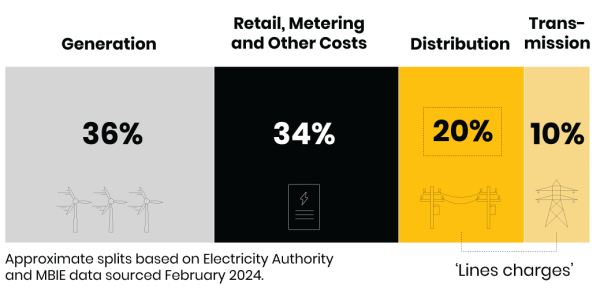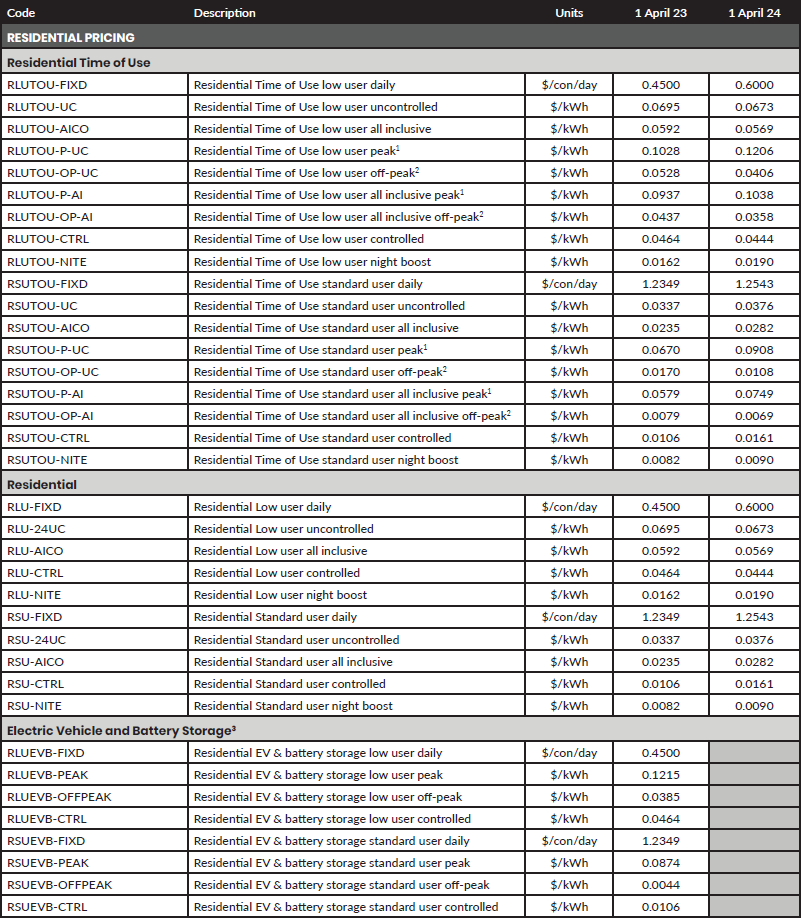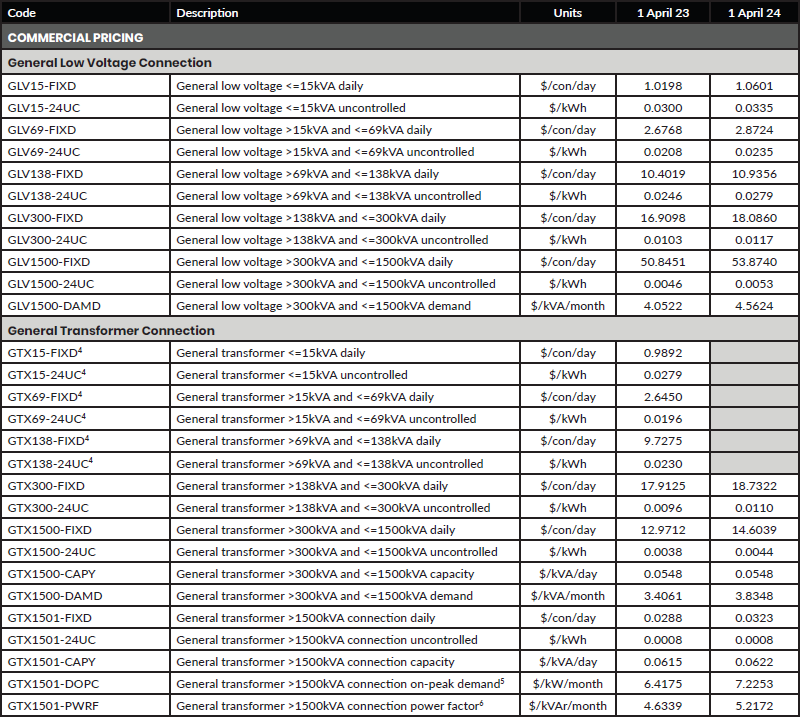Lines charges for Wellington Electricity consumers from 1 April 2024
Who is Wellington Electricity?
Wellington Electricity is your local lines company responsible for managing the poles, wires and equipment that safely deliver electricity to Wellington, Porirua and the Hutt Valley. Our prices and quality standards are regulated under Part 4 of the Commerce Act, which is governed by the Commerce Commission.
What makes up the cost of supplying electricity?
New Zealand’s electricity system is made up of a number of suppliers, each providing a different service. The average power bill contributes to the following costs:

We combine our distribution charges with Transpower’s transmission charges (the cost of running the National Grid) to make up lines charges, which electricity retailers (who you pay for power) then re-package with their own costs to make up your power bill. Retailer costs include the amount they pay generators, who create and sell electricity to them.
What’s changed?
Our prices have increased by an average of 7.3%, mainly due to inflation. The new prices also include changes we’ve made to encourage and reward consumers for using electricity away from the busy weekday morning and evening periods.
The changes for each consumer group are outlined below:
Residential consumers
- Time of Use (ToU) pricing helps keep our network running smoothly. That’s why we’ve improved it to better reflect the higher costs of using electricity during busy times. We’ve also combined the Electric Vehicle and Battery Storage (EVB) plans with our ToU plans. EVB consumers will be moved to the equivalent ToU plan on 1 April 2024.
- Low user price increases are higher than average. This is a short-term effect that’s necessary for the gradual removal of the Low Fixed Charge Tariff regulations. Visit the Ministry of Business, Innovation & Employment (MBIE)’s website to find out more.
MBIE has set up a power credits scheme to support low-use households who are struggling to pay their power bills during the Low Fixed Charge Tariff regulations phase-out.
- Standard user price increases are lower than average as the Low Fixed Charge Tariff regulations are removed and standard and low user prices are gradually aligned.
Commercial consumers
- Overall, commercial consumers will see a higher-than-average price increase. This increase is due to inflation and the progressive application of the Electricity Authority’s new Transmission Pricing Methodology (TPM).
The TPM sets our share of Transpower’s transmission charges that we must pass through to consumers (via electricity retailers) and how we allocate those costs between different consumer categories. The new methodology means we allocate more of the cost to commercial consumers and less to residential consumers.
- Small dedicated transformer connection plans (GTX15, GTX69 and GTX138) are being combined with the equivalent general low voltage connection plan on 1 April 2024. This helps simplify our prices.
Note:
- How these changes affect you will depend on how your electricity retailer packages our lines charges.
- Only the lines charges portion of your power bill will be affected by these changes, which is less than a third of the total costs.
Preparing for a carbon neutral future
The New Zealand Government has pledged to reach net-zero emissions by 2050. Amongst other things, this means that electricity will be used to fuel more cars and public transport, which will significantly increase the demand for power.
Our electricity network has busy (peak) times, like roads at rush hour. If there’s more electricity being used than our equipment can handle, we’ll need to build a bigger network to increase capacity. But if people shift their power usage away from these busy periods, we won’t have to do this as quickly and can keep prices as low as possible.
This is where our Time of Use pricing plans come in. They reward consumers with cheaper rates for using electricity when our network is less busy (off-peak). Using washing machines and dryers and charging electric vehicles off-peak means we can all do our bit for the environment too, as power is often generated at these times without the need for fossil fuels. Plus, it’ll help keep the National Grid running smoothly across Aotearoa.
Table of price changes



Footnotes
1. The Residential Time of Use plan peak hours are 7:00am – 11:00am and 5:00pm – 9:00pm Monday to Friday (including public holidays).
2. The Residential Time of Use plan off-peak hours are 9:00pm – 7:00am and 11:00am – 5:00pm Monday to Friday (including public holidays), and all weekend.
3. The Electric Vehicle and Battery Storage (EVB) plan will be combined with the Residential Time of Use (ToU) plan. EVB consumers will be moved to the equivalent ToU plan on 1 April 2024.
4. General Transformer Connection plans GTX15, GTX69 and GTX138 are being combined with the equivalent General Low Voltage Connection (GLV) plan. These consumers will be moved to the equivalent GLV plan on 1 April 2024.
5. On-peak demand charge is applicable to demand measured from 7:30am – 9:30am and 5:30pm – 7:30pm Monday to Friday (including public holidays).
6. Power factor charge is applicable for power factor <0.95 from 7:00am – 8:00pm on weekdays where the kVAr charge amount represents twice the largest difference between the recorded kVArh and one third of the recorded kWh in any one half-hour period.
7. Street lighting charges are provided to retailers who in turn bill councils and other parties. Streetlights are charged per fitting rather than on energy usage to better reflect the costs of maintaining the streetlight network.
8. we* has a number of codes for small scale distributed generation volumes, being RLUTOU-DGEN, RSUTOU-DGEN, RLU-DGEN, RSU-DGEN, GLV15-DGEN, GLV69-DGEN, GLV138-DGEN, GLV300-DGEN, GLV1500-DGEN, GTX300-DGEN, GTX1500-DGEN and GTX1501-DGEN.
All charges are exclusive of GST. Lines charges are quoted inclusive of transmission charges, other pass-through costs and recoverable components.
Related Documents
Time of Use pricing
Find out more about Time of Use pricing.
Future pricing
Learn about our plans and see our Pricing Roadmap.



To help improve our service, what feedback can you give us about this page?